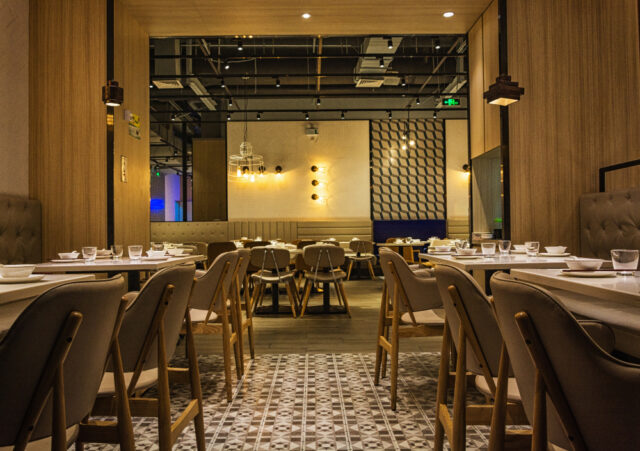
Restaurant tables in busy venues require daily cleaning routines to maintain hygiene and customer satisfaction. Start by wiping down tables with a damp cloth after each use, followed by a food-safe disinfectant to eliminate bacteria and viruses. For sticky residues, use a mild soap and warm water solution. Avoid using abrasive sponges that can scratch surfaces. In high-traffic environments, it’s essential to sanitize restaurant tables multiple times a day, especially during peak hours. Also, check and clean table bases and legs, which often accumulate dirt and debris. Having a visible cleaning schedule reassures customers and reinforces your commitment to cleanliness. Using microfiber cloths and quick-drying sanitizers ensures tables are ready for the next guests promptly. A consistent cleaning routine preserves the look and functionality of your restaurant tables while promoting a positive dining experience.
How to Maintain Wooden Restaurant Tables Without Damaging the Finish
Wooden restaurant tables add warmth and character but need gentle care to maintain their finish. Begin by dusting regularly with a soft, dry cloth to prevent buildup. Use a damp (not wet) cloth and mild soap for spills, then immediately dry the surface to avoid water damage. Avoid ammonia-based cleaners or harsh chemicals that strip the protective coating. Applying furniture polish or wood conditioner periodically can preserve the sheen and prevent cracking. Always use placemats or coasters to protect from heat, moisture, and food stains. For scratches, use a touch-up pen or wood filler matched to the table’s color. If your wooden restaurant tables are outdoors, ensure they’re sealed properly to resist humidity and temperature changes. With proper maintenance, these tables can age beautifully while withstanding daily use. Preserving the finish extends their lifespan and keeps your restaurant’s aesthetic consistent and inviting.
Cleaning Metal Restaurant Tables to Prevent Rust and Wear
Metal restaurant tables offer durability and a modern look, but they require specific care to avoid rust and wear. Daily cleaning should involve wiping down with a damp cloth and mild detergent. Avoid acidic or abrasive cleaners, which can corrode metal surfaces over time. For stainless steel, use specialized stainless-steel cleaners to maintain shine and prevent water spots. If the table features powder coating or painted metal, ensure the finish remains intact by drying surfaces thoroughly after cleaning. To prevent rust, keep metal restaurant tables dry and store them in covered areas when not in use—especially outdoor furniture. Apply a rust inhibitor or protective wax seasonally for added protection. Inspect joints and screws regularly for signs of corrosion or loosening. With routine upkeep, metal restaurant tables remain sturdy and attractive, offering reliable performance and a sleek appearance in your dining space.
Best Practices for Sanitizing Laminate Restaurant Tables Safely
Laminate restaurant tables are a popular choice for their affordability and easy maintenance. To clean them safely, use a soft cloth with warm water and a mild dish detergent to remove food residue. Avoid saturated cloths or soaking the table, as water can seep into seams and cause the laminate to lift or peel. Disinfect with a food-safe sanitizing spray that’s free from bleach or alcohol, which can degrade the laminate over time. Avoid abrasive pads that may scratch the surface. For stubborn stains, a mixture of baking soda and water can be gently applied. Never use steam cleaners on laminate surfaces. Consistent daily cleaning and proper sanitizing keep laminate restaurant tables looking fresh while preventing surface damage. Their non-porous design makes them ideal for high-turnover settings when paired with proper care techniques that preserve their finish and function.
Maintaining Marble and Stone Restaurant Tables: Do’s and Don’ts
Marble and stone restaurant tables exude luxury but require delicate handling. Always clean spills immediately—especially acidic ones like lemon juice, wine, or vinegar—to avoid etching or staining. Use a pH-neutral cleaner and a soft cloth for routine cleaning; avoid anything abrasive or acidic. Sealing the surface every few months provides an extra layer of protection against moisture and stains. Do not place hot plates directly on the surface—use trivets or mats instead. For dried stains, gently scrub with a soft brush and a baking soda paste. Avoid dragging items across the table to prevent scratches. Since marble is porous, regular maintenance is key to preserving its elegance. Restaurant tables made of stone offer a refined look, but their longevity depends on consistent care and proper product use. These maintenance tips ensure that your high-end stone tables stay pristine and guest-ready.
Waterproofing and Weatherproofing Outdoor Restaurant Tables
Outdoor restaurant tables face exposure to sun, rain, and humidity, making waterproofing essential. Choose materials like treated wood, powder-coated metal, or HDPE plastic, which are naturally weather-resistant. Apply a sealant to wooden tables to prevent moisture absorption and fading. For metal tables, use rust-proof coatings and inspect regularly for chips or scratches in the finish. Covers are useful for protection during off-hours or inclement weather. Keep outdoor restaurant tables on level ground to prevent pooling water. Clean surfaces regularly to remove dirt and grime, which can wear down protective layers. Consider investing in furniture glides or rubber feet to prevent moisture from seeping into the legs. With the right materials and maintenance, your outdoor restaurant tables can endure the elements while remaining functional and stylish. This proactive approach saves costs in the long run and extends your tables’ usability season after season.
How to Remove Stains and Scratches from Restaurant Tables
Stains and scratches are common issues with restaurant tables, but most can be managed with the right approach. For wood tables, use a soft cloth and a baking soda paste to gently remove light stains. For deeper marks, furniture markers or wax sticks matched to the wood color can conceal blemishes. Laminate tables often respond well to diluted vinegar or gentle scrubbing with non-abrasive cleaners. Stone surfaces require pH-neutral stain removers and soft bristle brushes. For metal tables, fine steel wool or metal polish can reduce surface scratches. Always test any cleaning method on an inconspicuous area first. To avoid future damage, use placemats and coasters. Regular maintenance combined with spot treatments ensures your restaurant tables maintain a professional, polished look, even with heavy use. Quick action and the right materials are key to keeping surfaces looking as good as new.
Recommended Cleaning Products for Different Restaurant Tables
Selecting the right cleaning products is crucial for preserving the quality of restaurant tables. For wood, use oil-based or natural wood cleaners that nourish the grain without stripping the finish. Laminate surfaces respond well to mild dish soap and water, while stainless steel tables benefit from specific stainless steel sprays that reduce streaking. For stone or marble tables, always use pH-neutral cleaners to avoid etching. Avoid bleach, ammonia, and abrasive powders, which can cause permanent surface damage across all materials. Multi-surface disinfectants are ideal for daily sanitizing, but always verify they’re safe for food-contact surfaces. Microfiber cloths are highly recommended for all table types—they trap dust and bacteria without scratching. By choosing the appropriate cleaning products tailored to each material, you ensure your restaurant tables remain sanitary, durable, and visually appealing, creating a positive impression with every guest.
Setting a Cleaning Schedule to Prolong Restaurant Tables’ Lifespan
A structured cleaning schedule ensures your restaurant tables remain in top condition year-round. Begin by assigning daily, weekly, and monthly tasks to staff. Daily tasks include wiping surfaces with disinfectant after each use and checking for spills or crumbs beneath the table. Weekly tasks should involve inspecting for scratches, wobbling, or stains, and deep-cleaning table bases. Monthly tasks may include applying polish or sealant, tightening hardware, or refreshing protective coatings. Seasonal maintenance is essential for outdoor tables—clean, reseal, and store appropriately when not in use. Documenting cleaning routines helps maintain accountability and ensures consistent care, no matter who’s on shift. Use a checklist and logbook for easy tracking. With a reliable schedule, restaurant tables stay cleaner longer, show fewer signs of wear, and contribute to a professional dining environment. Preventive care is always more cost-effective than frequent repairs or replacements.
Training Staff on Proper Care for All Types of Restaurant Tables
Training your staff on proper care practices for restaurant tables is vital for long-term maintenance and customer satisfaction. Begin with an orientation that covers the specific materials used in your establishment—wood, metal, laminate, or stone—and how each should be cleaned. Demonstrate the appropriate cleaning techniques, including which cloths and products to use or avoid. Staff should understand the difference between sanitizing and damaging a surface. Provide a clear cleaning schedule and assign responsibilities to ensure consistency. Reinforce the importance of reporting any damage, stains, or loose hardware immediately. Periodic refreshers and checklists help ensure that procedures remain consistent over time. Proper training not only protects your investment but also ensures that restaurant tables remain spotless, sturdy, and ready for guests. Well-informed staff are your first line of defense in maintaining the appearance and longevity of your furniture.
Conclusion: Keep Your Restaurant Tables Spotless and Strong
Proper maintenance of restaurant tables goes beyond cleanliness—it’s about protecting your investment, enhancing customer experience, and preserving your brand image. Each table material has its own care requirements, from gentle cleaning for wood to waterproofing outdoor options. Establishing a structured cleaning schedule, using appropriate products, and training your staff ensures long-lasting durability. With consistent attention to stains, scratches, and environmental wear, you can avoid costly repairs or early replacements. Clean, well-maintained restaurant tables create a polished impression, contribute to food safety, and reinforce your commitment to quality. Whether you run a cozy café, a busy bistro, or a fine dining venue, your tables play a central role in your guests’ experience. By following these care tips, you ensure your restaurant tables stay attractive, functional, and aligned with the high standards your business represents.
Disclaimer
The information contained in South Florida Reporter is for general information purposes only.
The South Florida Reporter assumes no responsibility for errors or omissions in the contents of the Service.
In no event shall the South Florida Reporter be liable for any special, direct, indirect, consequential, or incidental damages or any damages whatsoever, whether in an action of contract, negligence or other tort, arising out of or in connection with the use of the Service or the contents of the Service. The Company reserves the right to make additions, deletions, or modifications to the contents of the Service at any time without prior notice.
The Company does not warrant that the Service is free of viruses or other harmful components












